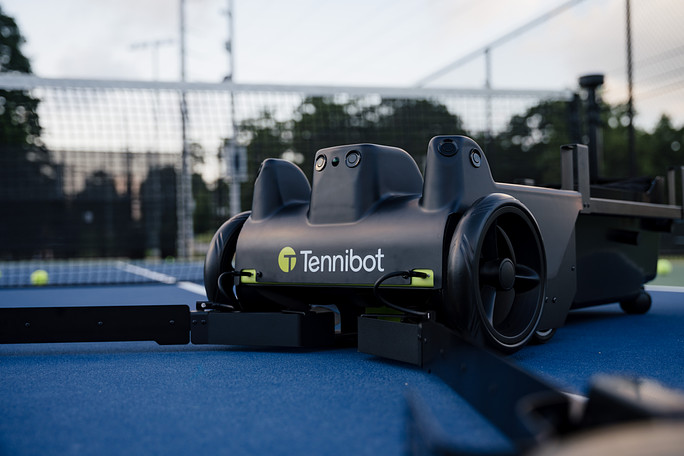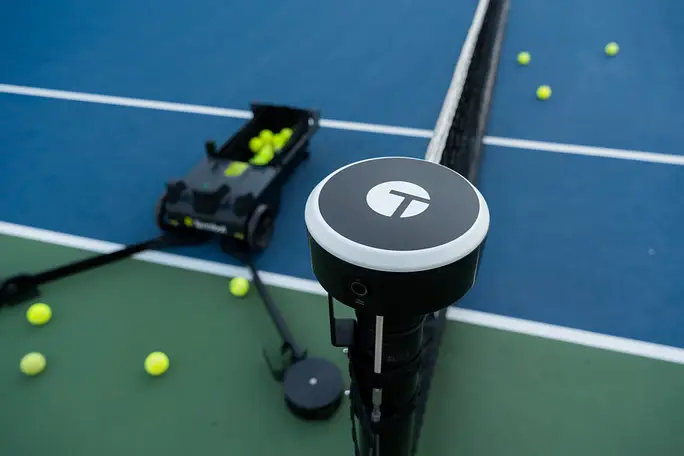You can ask almost any tennis player what the worst parts about practicing alone are and most if not all, will say something along the lines of time spent picking up balls on the court.
This is where Tennibot comes into the picture.
Tennibot is the world’s first robotic tennis ball collector.
Designed by Haitham Eletrabi and his co-founder Lincoln Wang, Tennibot has blown up on social media and sold $99K worth of products during its pre-sale campaign.
Over the past couple of years, the team has been quietly tinkering and iterating the product.
Now, they’re hitting their stride and ready to bring the Tennibot to the world.
In this interview, we discuss how they designed the initial MVP, the technology behind the robot, and how they plan to integrate it into other sports.
Hello, who are you and what is the name of your company?
My name is Haitham Eletrabi, and I am the co-founder and CEO of Tennibot.
I have a PhD in Civil Engineering and an MBA from Auburn University.
I’ve also played tennis for over fifteen years as a competitive doubles player and amateur coach.
Tennibot was born out of frustration one night when I was practicing with a ball machine and noticed I spent more time picking up balls than actually practicing.
After shopping around for a solution without any luck, I decided to build my own solution.
While prototyping & testing early versions of the Tennibot on the courts, players and coaches kept approaching me and asking where I bought it from.
Around this time I met my co-founder Lincoln who’s also a formidable tennis player and was finishing his Masters in Robotics & Control Systems.
Together we took the idea from a simple prototype/idea to a real business, driven by our passion for tennis and robotics.
What was the process of getting the company off the ground?
We initially designed and built all the early prototypes by ourselves that could move around the court and pick up balls.
This MVP was created with only core functionality in mind, ensuring it could perform its primary tasks.
After we successfully created this and received positive feedback, with a lot of tennis players wanting to buy the initial prototype, we launched a Kickstarter campaign.
The Kickstarter campaign reached its goal in a few hours and eventually tripled the goal by the end of the campaign!
The prototype was rudimentary but functional, serving as a proof of concept.
As we progressed, we tackled challenges in handling different fence types, court conditions, and autonomous navigation, eventually leading to our latest version of the Tennibot.
While working on the Tennibot, we applied and got accepted into the Techstars Accelerator Sports Program, a crucial step in the company’s trajectory.
In addition to the product, funding, and growing the team, we also applied for and received over 15 patents and trademarks in the US, Europe, Australia, Canada, and Japan.

How is the company doing today and what does the long-term vision look like?
Today, Tennibot is thriving with several significant milestones achieved in the past year.
We have shipped multiple batches of the Tennibot to early backers and finally started shipping new orders to customers worldwide!
We were not very active on social media until recently when we started posting videos of the Tennibot on Instagram and somehow two of those posts went viral attracting lots of website traffic and sales (3M & 5M views).
You can check out the posts here:
Our long-term vision includes continuing to add capabilities and features to the Tennibot (ex. We added the sweeper accessory after getting a lot of requests from coaches and clay court players to help them sweep the courts after matches and practices).
We are also working on a couple of exciting new products in the pipeline.
What key lessons have been particularly helpful or advantageous since starting the business?
I think the most valuable lesson was some of the earliest advice we received.
One of our first investors/mentors gave us very thoughtful advice and it was to resist the temptation of just doing one large production batch to deliver all the preorders and get it over with.
Instead, build them in small batches and ensure every batch is 10x better than the previous one.
By building in small batches and iterating the product based on customer feedback we were able to stay lean, keep the burn rate low, and build an amazing product that our customers love.
Another key lesson we received from another mentor, thanks to Jordan Fliegel, was to adjust our pricing model to match the different customer personas that would be an ideal customer.
This lesson made an impact on our sales and growth almost immediately!

From a high-level perspective, can you explain the technology behind Tennibot?
Sure, Tennibot uses computer vision, machine learning, and AI to eliminate the most tedious parts of racquet sports.
This involves detecting balls, players & lines under various lighting and weather conditions, obstacle avoidance, court mapping, player tracking, and autonomous navigation on the court.
All of those capabilities are combined to provide a seamless & intuitive experience for the players and coaches.
Do you see this being applicable in other racquet sports? If so, what are some of the challenges that you anticipate entering those sports?
Absolutely.
We see great potential for Tennibot in other racquet sports such as pickleball, padel, and maybe even badminton a little later down the road.
While Pickleball and Padel are pretty straightforward from a product design stance, each sport presents unique challenges, such as different court dimensions, ball types, and play dynamics.
The challenge moving forward is making the software compatible with both pickleball and padel as the court dimensions are smaller than a tennis court.
Badminton will be a whole different monster, but the basics are very similar.
On top of this, tapping into each one of these markets will require a new understanding of our potential customers and typical use cases.
For example, we were skeptical at first of the pickleball as a viable market because of the smaller court size, but we have been fielding calls/emails weekly from customers asking for a pickleball version.
Not to mention, the pickleball machines are almost always sold out!
How are you all thinking about acquiring customers and growth?
Our customer acquisition strategy involves a mix of organic growth, strategic marketing, and direct outreach.
Due to the nature of the product, our customers are broken into two categories, B2B (clubs, coaches, schools, and tennis programs) and B2C (players who take lessons, play twice a week or more, own or have access to ball machines).
We continuously refine our customer personas and update our messaging to curate to their pain point.
We tested a lot of strategies and messaging with our outreach and ads to learn what works and what doesn’t work and explored various marketing channels, including social media, email marketing, and direct outreach to clubs and coaches.
In addition to all of this, we made sure that every customer gets white-glove customer service.
Even though it is still early, we are seeing continuous growth in all the meaningful metrics that we are tracking (ex. website visits, conversions, and orders).

How big do you see this getting and what are your thoughts about the growth of racquet sports in the US?
At first glance, an autonomous robot for tennis might give an impression of a niche market but when you realize that there are millions of tennis ball machines currently in the market and you factor in the strong similarity in pain points for the two products, and then consider the average income level of regular tennis players, you can do the math and realize that there is a significant potential upside of the product and market.
We still haven’t even addressed or accounted for the meteoric growth of racquet sports (tennis, pickleball & padel) in the US and around the world.
There is a new facility for racquet sports being built almost on a bi-weekly basis!
I believe the racquet sports will continue to grow in the US over the foreseeable future.
The barrier to entry is low, the sports are fun and engaging, easy to find partners and opponents, and the health benefits are well documented.
What are some predictions you have for robotics in the sports industry over the next several years?
I believe that over the next couple of years, we will start seeing more proliferation of robotics, computer vision, and AI in different sports.
It already started with companies like Grind & SportsVisio in Basketball and MVP & Monarc in football.
As players and coaches start seeing the value those solutions add to the game, whether it is improved training, better play experience, or advanced analytics, the question becomes how fast can those technologies be implemented.
Additionally, I expect we will see robots that are targeted to enhance fan experiences at sporting events.
Robots could serve as interactive guides, provide live game updates, and even offer services like food delivery within stadiums.
Are you currently hiring and/or raising capital? If so, where can people find out more?
Yes, we are currently hiring for various positions, you can learn more on our careers page.
Regarding fundraising, we will be opening a new round in a couple of weeks.
If you’d like to chat or learn more about Tennibot, you can email me at haithame@tennibot.com.

